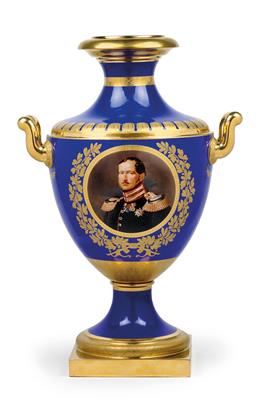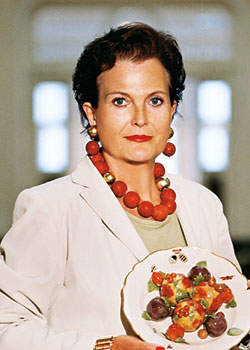A large imperial vase featuring the portrait of 'König Friedrich Wilhelm III. von Preussen',
A large imperial vase featuring the portrait of 'König Friedrich Wilhelm III. von Preussen',

porcelain, sides with Prussian blue ground, wide golden edge of opening, border with glossy golden décor on matte golden band, shoulder with matte golden lancette frieze and glossy golden inside drawing, baluster at front with medallion and bearing the portrait of King Friedrich Wilhelm III, his head turned to the left, in dark blue uniform with silver epaulets, high red collar with golden braids, decorated with five medals, including the Order of the Black Eagle, on brown ground, framed by matte golden arch frieze on glossy golden ground, flanked by gold etched oak branches joined at centre, reverse side featuring the gold etched Prussian eagle with monogram RFW, gold etched frame with laurel festoons and angular bands on glossy golden ground, also flanked by gold etched oak branches joined at centre, base of body with matte golden arch frieze on glossy golden ground, edge of foot with gold etched laurel festoons and angular bands on glossy golden ground, square glossy golden plinth, wide glossy golden handles with matte golden rosette base, under which matte gold etched acanthus foliate arrangements with laurel branches at the sides, height 63.5 cm, edge of opening on underside and one plinth corner with minor restored area, KPM-Berlin, underglaze blue sceptre mark, around 1840, model Münchner Vase No. 2 (Ru)
See Lit..:
: E. Köllmann, M. Jarchow, Berliner Porzellan II, p 583, fig. 548,549, p 587, fig. 554, 555;
Friedrich Wilhelm III, Potsdam 3.8.1770-7.6.1840 Berlin, son of King Friedrich Wilhelm II and Friederike von Hessen- Darmstadt. King of Prussia since 1797, as Markgraf of Brandenburg also Elector of the Holy Roman Empire until this Empire was dissolved in 1806. Descended from the German royal house of Hohenzollern. He continued the policy of neutrality in the understanding of the Peace of Basel, but this led to isolation and dependence on Napoleon I; was able to greatly expand Prussia in 1803 and 1805/06. In 1806, he hastily entered a war against Napoleon, after suffering defeat at Jena and Auerstedt he had to accept the abasing Peace of Tilsit in 1807. On 24.12.1793 he married Luise zu Mecklenburg-Strelitz. The love of this woman was a happy experience for this man, who had until then felt little love. The Kronprinzenpalais Unter den Linden in Berlin, where he still lived once he was King, and the humble palace Paretz near Potsdam was where Friedrich Wilhelm led an almost civilian lifestyle and model marriage. Prussian history was, however, much more decisively shaped by his uncle Friedrich II, the Great. The portrait on this vase was painted by Paul Ernst Gebauer, Lietzen 23.5.1782- 7.7.1865 Berlin. Title: König Friedrich Wilhelm III. von Preußen in Uniform und Ordensschmuck, dated 1838. Ernst Gebauer was a Prussian portrait and court painter. Especially well known are his works from the wars of liberation against Napoleonic rule. King Friedrich Wilhelm III sponsored his education.
Esperta: Ursula Rohringer
 Ursula Rohringer
Ursula Rohringer
+43-1-515 60-382
ursula.rohringer@dorotheum.at
02.05.2019 - 14:00
- Stima:
-
EUR 50.000,- a EUR 70.000,-
A large imperial vase featuring the portrait of 'König Friedrich Wilhelm III. von Preussen',
porcelain, sides with Prussian blue ground, wide golden edge of opening, border with glossy golden décor on matte golden band, shoulder with matte golden lancette frieze and glossy golden inside drawing, baluster at front with medallion and bearing the portrait of King Friedrich Wilhelm III, his head turned to the left, in dark blue uniform with silver epaulets, high red collar with golden braids, decorated with five medals, including the Order of the Black Eagle, on brown ground, framed by matte golden arch frieze on glossy golden ground, flanked by gold etched oak branches joined at centre, reverse side featuring the gold etched Prussian eagle with monogram RFW, gold etched frame with laurel festoons and angular bands on glossy golden ground, also flanked by gold etched oak branches joined at centre, base of body with matte golden arch frieze on glossy golden ground, edge of foot with gold etched laurel festoons and angular bands on glossy golden ground, square glossy golden plinth, wide glossy golden handles with matte golden rosette base, under which matte gold etched acanthus foliate arrangements with laurel branches at the sides, height 63.5 cm, edge of opening on underside and one plinth corner with minor restored area, KPM-Berlin, underglaze blue sceptre mark, around 1840, model Münchner Vase No. 2 (Ru)
See Lit..:
: E. Köllmann, M. Jarchow, Berliner Porzellan II, p 583, fig. 548,549, p 587, fig. 554, 555;
Friedrich Wilhelm III, Potsdam 3.8.1770-7.6.1840 Berlin, son of King Friedrich Wilhelm II and Friederike von Hessen- Darmstadt. King of Prussia since 1797, as Markgraf of Brandenburg also Elector of the Holy Roman Empire until this Empire was dissolved in 1806. Descended from the German royal house of Hohenzollern. He continued the policy of neutrality in the understanding of the Peace of Basel, but this led to isolation and dependence on Napoleon I; was able to greatly expand Prussia in 1803 and 1805/06. In 1806, he hastily entered a war against Napoleon, after suffering defeat at Jena and Auerstedt he had to accept the abasing Peace of Tilsit in 1807. On 24.12.1793 he married Luise zu Mecklenburg-Strelitz. The love of this woman was a happy experience for this man, who had until then felt little love. The Kronprinzenpalais Unter den Linden in Berlin, where he still lived once he was King, and the humble palace Paretz near Potsdam was where Friedrich Wilhelm led an almost civilian lifestyle and model marriage. Prussian history was, however, much more decisively shaped by his uncle Friedrich II, the Great. The portrait on this vase was painted by Paul Ernst Gebauer, Lietzen 23.5.1782- 7.7.1865 Berlin. Title: König Friedrich Wilhelm III. von Preußen in Uniform und Ordensschmuck, dated 1838. Ernst Gebauer was a Prussian portrait and court painter. Especially well known are his works from the wars of liberation against Napoleonic rule. King Friedrich Wilhelm III sponsored his education.
Esperta: Ursula Rohringer
 Ursula Rohringer
Ursula Rohringer
+43-1-515 60-382
ursula.rohringer@dorotheum.at
|
Hotline dell'acquirente
lun-ven: 09.00 - 18.00
kundendienst@dorotheum.at +43 1 515 60 200 |
| Asta: | Mobili e oggetti d'arte |
| Tipo d'asta: | Asta in sala |
| Data: | 02.05.2019 - 14:00 |
| Luogo dell'asta: | Wien | Palais Dorotheum |
| Esposizione: | 20.04. - 02.05.2019 |
